Triumph Rocket 3 2005 Owner's manual

Foreword
FOREWORD
This handbook contains information on the Triumph Rocket III motorcycle. Always store this owner's handbook with the motorcycle and refer to it for information whenever necessary.
cblz
Warning, Caution and |
|
|
|
|
|
|
|
|
|||||
|
|
|
|
|
|
|
|
||||||
Note |
|
|
|
|
|
|
|
|
|
Caution |
|||
Throughout |
|
this |
owner's |
handbook |
|
|
|
|
|
|
|
|
|
|
|
This |
|
caution |
symbol |
identifies |
|||||||
particularly |
important information is |
|
|
||||||||||
|
special instructions or procedures, |
||||||||||||
presented in the following form: |
|
||||||||||||
|
which, if not strictly observed, could |
||||||||||||
|
|
|
|
|
|
|
|||||||
|
|
|
|
|
|
|
result in damage to, or destruction |
||||||
|
|
|
Warning |
||||||||||
|
|
|
|
of, equipment. |
|
|
|||||||
|
|
|
|
|
|
|
|
|
|||||
|
|
|
|
|
|
|
|
|
|
|
|
|
|
|
|
|
|
|
|
|
NOTE |
|
|
|
|
||
This warning |
symbol |
identifies |
|
|
|
|
|||||||
|
• |
This |
note |
symbol |
indicates |
||||||||
special instructions or procedures, |
|
||||||||||||
|
|
points of |
particular interest |
||||||||||
which if not correctly followed could |
|
|
|||||||||||
|
|
for |
more efficient and |
||||||||||
result in personal injury, or loss of |
|
|
|||||||||||
|
|
convenient operation. |
|||||||||||
life. |
|
|
|
|
|
|
|||||||
|
|
|
|
|
|
|
|
|
|
|
|
||
|
|
|
|
|
|
|
|
|
|
|
|
|
|
|
|
|
|
|
|
|
|
|
|
|
|
|
|
|
|
|
|
|
|
|
|
|
|
|
|
|
1 |
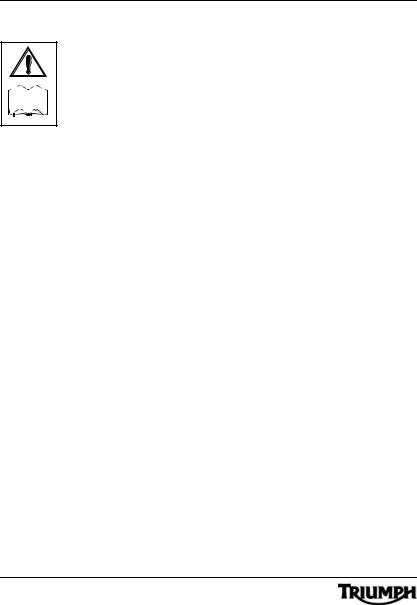
Foreword
Warning Labels
At certain areas of the motorcycle, the symbol (right) can be seen. The symbol means 'CAUTION: REFER TO THE HANDBOOK' and will be followed by a
pictorial representation of the subject concerned.
Never attempt to ride the motorcycle or make any adjustments without reference to the relevant instructions contained in this handbook.
See pages 12 and 13 for the location of all labels bearing this symbol. Where necessary, this symbol will also appear on the pages containing the relevant information.
Maintenance
To ensure a long, safe and trouble free life for your motorcycle, maintenance should only be carried out by an authorised Triumph dealer.
Their address is given in the service record book that accompanies this handbook.
Noise Control System
Tampering With the Noise Control System is Prohibited
Owners are warned that the law may prohibit:
a)The removal or rendering inoperative by any person other than for purposes of maintenance, repair or replacement, of any device or element of design incorporated into any new vehicle for the purpose of noise control prior to its sale or delivery to the ultimate purchaser or while it is in use and,
b)the use of the vehicle after such device or element of design has been removed or rendered inoperative by any person.
Only an authorised Triumph dealer will have the necessary knowledge, equipment and skills to maintain your Triumph motorcycle correctly.
To locate your nearest Triumph dealer, visit the Triumph web-site at www.triumph.co.uk or telephone the authorised distributor in your country.
Owner's Handbook
Thank you for choosing a Triumph motorcycle. This motorcycle is the product of Triumph's use of proven engineering, exhaustive testing, and continuous striving for superior reliability, safety and performance. Please read this owner's handbook before riding in order to become
2

Foreword
thoroughly familiar with the correct operation of your motorcycle's controls, its features, capabilities and limitations.
This handbook includes safe riding tips, but does not contain all the techniques and skills necessary to ride a motorcycle safely. Triumph strongly recommends that all riders undertake the necessary training to ensure safe operation of this motorcycle.
Warning
This owner's handbook, and all other instructions that are supplied with your motorcycle, should be considered a permanent part of your motorcycle and should remain with it even if your motorcycle is subsequently sold.
All riders must read this owner's handbook and all other instructions which are supplied with your motorcycle, before riding, in order to become thoroughly familiar with the correct operation of your motorcycle's controls, its features, capabilities and limitations. Do not lend your motorcycle to others as riding when not familiar with your motorcycle's controls, features, capabilities and limitations can lead to an accident.
Information
The information contained in this publication is based on the latest information available at the time of printing. Triumph reserves the right to make changes at any time without prior notice, or obligation.
Not to be reproduced wholly or in part without the written permission of Triumph Motorcycles Limited.
© Copyright 2005 Triumph Motorcycles Limited, Hinckley, Leicestershire, England.
Publication part number 3850351 issue 4.
3
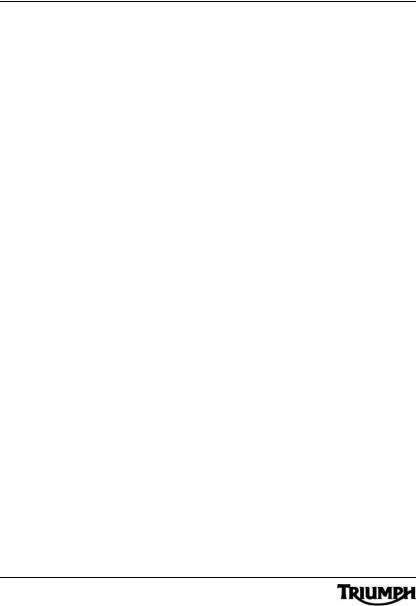
Foreword
Table of Contents
This handbook contains a number of different sections. The table of contents below will help you find the beginning of each section where, in the case of the major sections, a further table of contents will help you find the specific subject required.
Foreword ..................................................................................................... |
1 |
Warning Labels.......................................................................................... |
12 |
Parts Identification..................................................................................... |
14 |
Serial Numbers.......................................................................................... |
17 |
General Information................................................................................... |
19 |
How to Ride the Motorcycle....................................................................... |
35 |
Accessories, Loading and Passengers ..................................................... |
47 |
Maintenance and Adjustment.................................................................... |
51 |
Storage ...................................................................................................... |
93 |
Specifications ............................................................................................ |
95 |
4

Foreword - Safety First
FOREWORD - SAFETY FIRST
The Motorcycle
Warning
This motorcycle is designed for onroad use only. It is not suitable for off-road use.
Off-road operation could lead to loss of control of the motorcycle resulting in an accident causing injury or loss of life.
Warning
This motorcycle is not designed to tow a trailer or be fitted with a sidecar. Fitting a sidecar and/or a trailer may result in loss of control and an accident.
Warning
This motorcycle is designed for use as a two-wheeled vehicle capable of carrying a rider on his/her own, or a rider and one passenger (subject to a passenger seat being fitted).
The total weight of the rider, and any passenger, accessories and luggage must not exceed the maximum load limit of 235 kg.
5
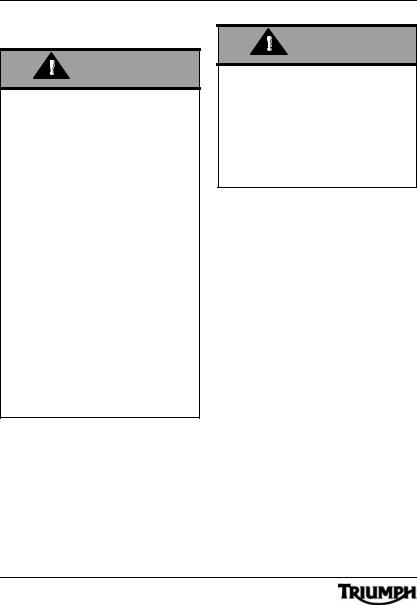
Foreword - Safety First
Fuel and Exhaust Fumes
Warning
PETROL IS HIGHLY
FLAMMABLE:
Always turn off the engine when refuelling.
Do not refuel or open the fuel filler cap while smoking or in the vicinity of any open (naked) flame.
Take care not to spill any petrol on the engine, exhaust pipes or silencers when refuelling.
If petrol is swallowed, inhaled or allowed to get into the eyes, seek immediate medical attention.
Spillage on the skin should be immediately washed off with soap and water and clothing contaminated with petrol should immediately be removed.
Burns and other serious skin conditions may result from contact with petrol.
Warning
Never start your engine or let it run for any length of time in a closed area. The exhaust fumes are poisonous and may cause loss of consciousness and death within a short time. Always operate your motorcycle in the open-air or in an area with adequate ventilation.
6
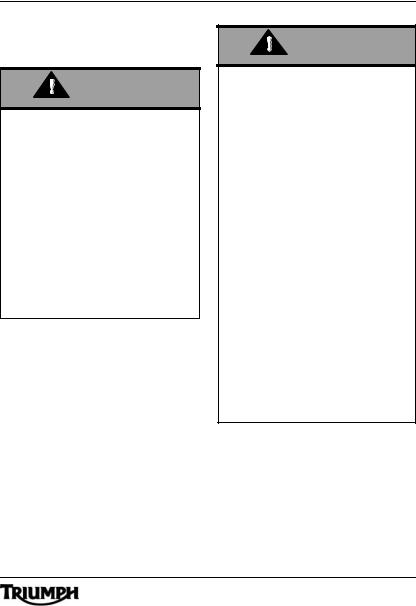
Foreword - Safety First
Safety Helmet and
Clothing
Warning
When riding the motorcycle, both rider and passenger must always wear a motorcycle safety helmet, eye protection, gloves, trousers (close fitting around the knee and ankle) and a brightly coloured jacket. Brightly coloured clothing will considerably increase a rider's (or passenger's) visibility to other operators of road vehicles. Although full protection is not possible, wearing correct protective clothing can reduce the risk of injury when riding.
Warning
A safety helmet is one of the most important pieces of riding gear as it offers protection against head injuries. You and your passenger's helmet should be carefully chosen and should fit you or your passenger's head comfortably and securely. A brightly coloured helmet will increase a rider's (or passenger's) visibility to other operators of road vehicles.
An open face helmet offers some protection in an accident though a full face helmet will offer more.
Always wear a visor or approved goggles to help vision and to protect your eyes.
7

Foreword - Safety First
Parking |
Parts and Accessories |
Warning
Always turn off the engine and remove the ignition key before leaving the motorcycle unattended. By removing the key, the risk of use of the motorcycle by unauthorised or untrained persons is reduced.
When parking the motorcycle, always remember the following: Engage first gear to help prevent the motorcycle from rolling off the stand.
The engine and exhaust system will be hot after riding. DO NOT park where pedestrians, animals and/or children are likely to touch the motorcycle.
Do not park on soft ground or on a steeply inclined surface. Parking under these conditions may cause the motorcycle to fall over.
For further details, please refer to the ’How to Ride the Motorcycle' section of this owner's handbook.
Warning
Owners should be aware that the only approved parts, accessories and conversions for any Triumph motorcycle are those which carry official Triumph approval and are fitted to the motorcycle by an authorised dealer.
Triumph does not accept any liability whatsoever for defects caused by the fitting of nonapproved parts, accessories or conversions or the fitting of any approved parts, accessories or conversions by non-approved personnel.
In particular, it is extremely hazardous to fit or replace parts or accessories whose fitting requires the dismantling of, or addition to, either the electrical or fuel systems and any such modification could cause a safety hazard.
The fitting of any non-approved parts, accessories or conversions may adversely affect the handling, stability or other aspect of the motorcycle operation that may result in an accident causing injury or death.
8
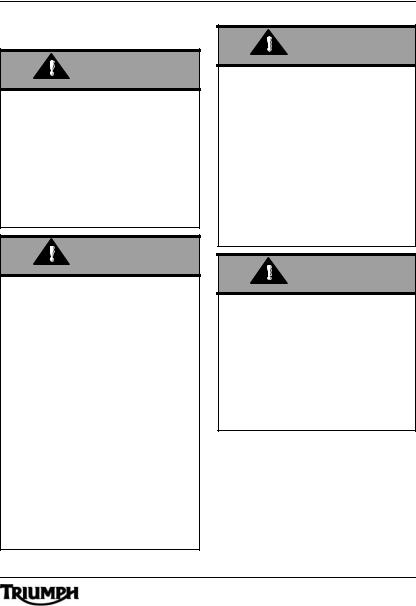
Foreword - Safety First
Maintenance/Equipment
Warning
Consult your authorised Triumph dealer whenever there is doubt as to the correct or safe operation of this Triumph motorcycle.
Remember that continued operation of an incorrectly performing motorcycle may aggravate a fault and may also prejudice safety.
Warning
Use of a motorcycle with bank angle indicators worn beyond the maximum limit (when the bank angle indicator is worn to a minimum of 5 mm in length) will allow the motorcycle to be banked to an unsafe angle. Therefore, always replace the bank angle indicator pegs when they are worn to 5 mm in length. Banking to an unsafe angle may cause instability, loss of motorcycle control and an accident.
Warning
Ensure all equipment that is required by law is installed and functioning correctly. The removal or alteration of the motorcycle’s lights, silencers, emission or noise control systems can violate the law. Incorrect or improper modification may adversely affect the handling, stability or other aspect of the motorcycle operation, which may result in an accident causing injury or death.
Warning
If the motorcycle is involved in an accident, collision or fall, it must be taken to an authorised Triumph dealer for inspection and repair. Any accident can cause damage to the motorcycle that, if not correctly repaired, may cause a second accident that may result in injury or death.
9
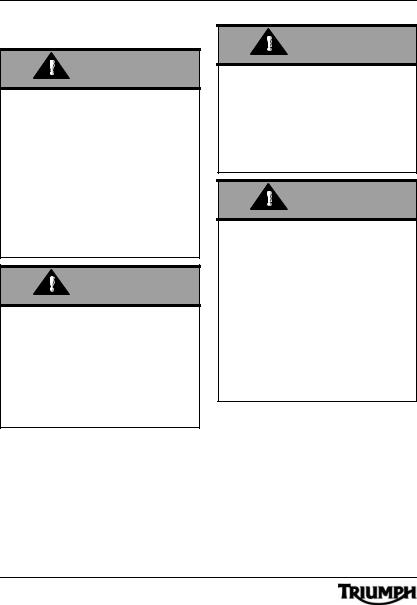
Foreword - Safety First
Riding
Warning
Never ride the motorcycle when fatigued or under the influence of alcohol or other drugs.
Riding when under the influence of alcohol or other drugs is illegal. Riding when fatigued or under the influence of alcohol or other drugs reduces the rider's ability to maintain control of the motorcycle and may lead to loss of control and an accident.
Warning
All riders must be licensed to operate the motorcycle. Operation of the motorcycle without a licence is illegal and could lead to prosecution. In addition, operation without a licence is dangerous and may lead to loss of motorcycle control and an accident.
Warning
Always ride defensively and wear the protective equipment mentioned elsewhere in this foreword. Remember, in an accident, a motorcycle does not give the same impact protection as a car.
Warning
This Triumph motorcycle should be operated within the legal speed limits for the particular road travelled. Operating a motorcycle at high speeds can be potentially dangerous since the time available to react to given traffic situations is greatly reduced as road speed increases. Always reduce speed in potentially hazardous driving conditions such as bad weather or heavy traffic.
10
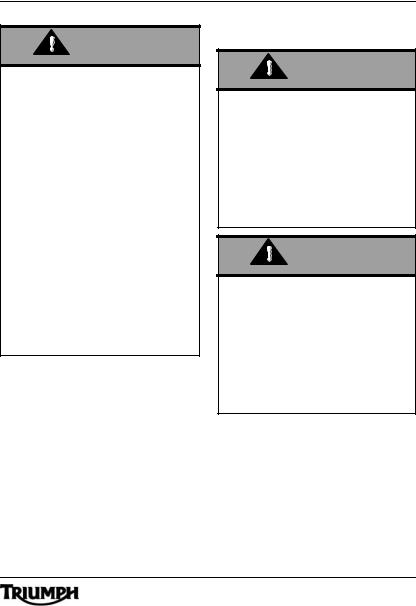
Foreword - Safety First
Warning
Continually observe and react to changes in road surface, traffic and wind conditions. All two-wheeled vehicles are subject to external forces which may cause an accident. These forces include but are not limited to:
•Wind draft from passing vehicles.
•Uneven or holed road surfaces.
•Bad weather.
•Rider error.
Always operate the motorcycle at moderate speed and away from heavy traffic until you have become thoroughly familiar with its handling and operating characteristics. Never exceed the legal speed limit.
Handlebars and Footrests
Warning
The rider must maintain control of the vehicle by keeping hands on the handlebars at all times.
The handling and stability of a motorcycle will be adversely affected if the rider removes his hands from the handlebars, resulting in loss of motorcycle control and an accident.
Warning
The rider and passenger must always use the footrests provided, during operation of the vehicle.
By using the footrests, both rider and passenger will reduce the risk of inadvertent contact with any motorcycle components and will also reduce the risk of injury from entrapment of clothing.
11
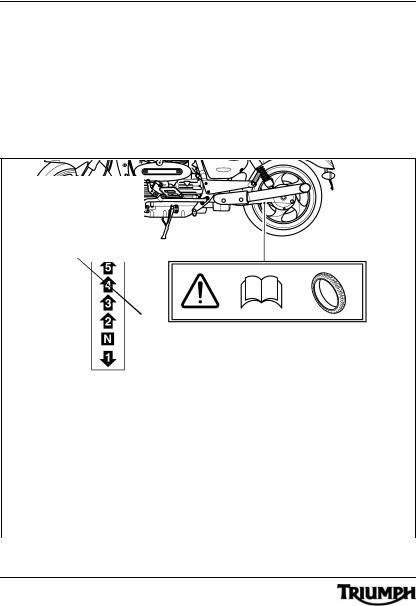
Warning Labels
WARNING LABELS
Warning Label Locations – Rocket III
The labels detailed on this and the following pages draw your attention to important safety information in this handbook. Before riding, ensure that all riders have understood and complied with all the information to which these labels relate.
Engine Oil
(page 56)
Coolant (page 60)
Gear Position
(page 38)
Tyres (page 76)
12

Warning Labels
Warning Label Locations – Rocket III (continued)
Unleaded Fuel
(page 30)
Safety Helmet
(page 7)
Daily Safety Checks
(page 33)
13
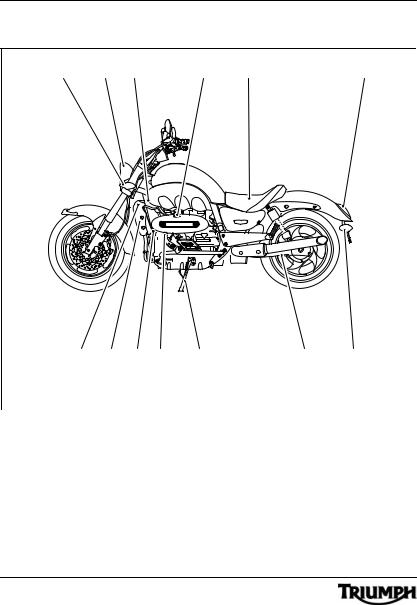
Parts Identification
PARTS IDENTIFICATION
1 |
2 |
|
3 |
|
|
|
|
|
|
4 |
|
5 |
6 |
||||||||||||||||||||||||||||||
|
|
|
|
|
|
|
|
|
|
|
|
|
|
|
|
|
|
|
|
|
|
|
|
|
|
|
|
|
|
|
|
|
|
|
|
|
|
|
|
|
|
|
|
|
|
|
|
|
|
|
|
|
|
|
|
|
|
|
|
|
|
|
|
|
|
|
|
|
|
|
|
|
|
|
|
|
|
|
|
|
|
|
|
|
|
|
|
|
|
|
|
|
|
|
|
|
|
|
|
|
|
|
|
|
|
|
|
|
|
|
|
|
|
|
|
|
|
|
|
|
|
|
|
|
|
|
|
|
|
|
|
|
|
|
|
|
|
|
|
|
|
|
|
|
|
|
|
|
|
|
|
|
|
|
|
|
|
|
|
|
|
|
|
|
|
|
|
|
|
|
|
|
|
|
|
|
|
|
|
|
|
|
|
|
|
|
|
|
|
|
|
|
|
|
|
|
|
|
|
|
|
|
|
|
|
|
|
|
|
|
|
|
|
|
|
|
|
|
|
|
|
|
|
|
|
|
|
|
|
|
|
|
|
|
|
|
|
|
|
|
|
|
|
|
|
|
|
|
|
|
|
|
|
|
|
|
|
|
|
|
|
|
|
|
|
|
|
|
|
|
|
|
|
|
|
|
|
|
|
|
|
|
|
|
|
|
|
|
|
|
|
|
|
|
|
|
|
|
|
|
|
|
|
|
|
|
|
|
|
|
|
|
|
|
|
|
|
|
|
|
|
|
|
|
|
|
|
|
|
|
|
|
|
|
|
|
|
|
|
|
|
|
|
|
|
|
|
|
|
|
|
|
13 |
12 |
11 10 |
9 |
|
8 |
7 |
|
cbnt |
|
|
|
|
|
|
|
|
|
|
|
|
|
|
1 |
Front Indicator |
|
|
9 |
Side Stand |
|
|
2 |
Headlamps |
|
|
|
10 |
Gear Change Pedal |
|
3 |
Coolant Expansion Tank |
|
11 |
Clutch Cable |
|
||
4 |
Oil Filler Cap/Dipstick |
|
12 |
Radiator |
|
||
5 |
Tool Kit beneath seat) |
|
13 |
Coolant Pressure Cap |
|||
6Rear Lamp
7Rear Indicator
8Transmission Shaft/Final Drive Unit
14
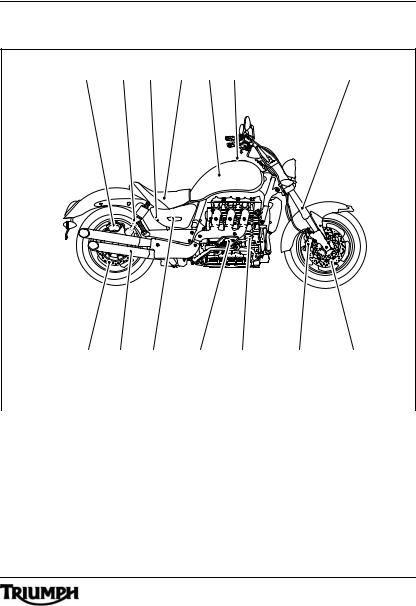
Parts Identification
14 |
15 |
|
16 |
17 18 |
19 |
|
20 |
||||||||||||||
|
|
|
|
|
|
|
|
|
|
|
|
|
|
|
|
|
|
|
|
|
|
|
|
|
|
|
|
|
|
|
|
|
|
|
|
|
|
|
|
|
|
|
|
|
|
|
|
|
|
|
|
|
|
|
|
|
|
|
|
|
|
|
|
|
|
|
|
|
|
|
|
|
|
|
|
|
|
|
|
|
|
|
|
|
|
|
|
|
|
|
|
|
|
|
|
|
|
|
|
|
|
|
|
|
|
|
|
|
|
|
|
|
|
|
|
|
|
|
|
|
|
|
|
|
|
|
|
|
|
|
|
|
|
|
|
|
|
|
|
|
|
|
|
|
|
|
|
|
|
|
|
|
|
|
|
|
|
|
|
|
|
|
|
|
|
|
|
|
|
|
|
|
|
|
|
|
|
|
|
|
|
|
|
|
|
|
|
|
|
|
|
|
|
|
|
|
|
|
|
|
|
|
|
|
|
|
|
|
|
|
|
|
|
|
|
|
|
|
|
|
|
|
|
|
|
|
|
|
|
|
|
|
|
|
|
|
|
|
|
|
|
|
|
|
|
|
|
|
|
|
|
|
|
|
|
|
|
|
|
|
|
|
|
|
|
|
|
|
|
|
|
|
|
|
|
|
|
|
|
|
|
|
|
|
|
|
|
|
|
|
|
|
|
|
|
|
|
|
|
|
|
|
|
|
|
|
|
|
27 |
26 |
25 |
24 |
23 |
22 |
21 |
|
cbns |
|
|
|
|
|
|
|
|
|
|
|
|
||
14 |
Rear Brake Caliper |
|
22 |
Front Brake Caliper |
|
||
15 |
Rear Suspension Unit |
|
23 |
Rear Brake Pedal |
|
||
16 |
Seat Lock |
|
|
24 |
Rear Brake Fluid Reservoir |
||
17 |
Battery (beneath seat) |
25 |
Engine Management ECM |
||||
18 |
Fuel Tank |
|
|
|
(beneath right hand side panel) |
||
|
|
26 |
Silencer |
|
|
||
19 |
Fuel Filler Cap |
|
|
|
|
||
|
|
27 |
Rear Brake Disc |
|
|||
20 |
Front Fork |
|
|
|
|||
|
|
|
|
|
|
||
21 |
Front Brake Disc |
|
|
|
|
|
|
15
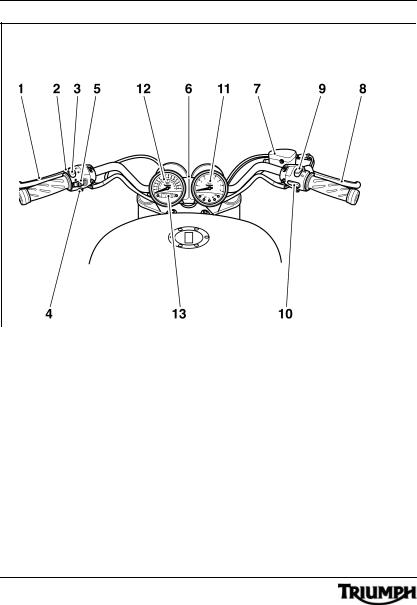
Parts Identification
1Clutch Lever
2Clutch Lever Adjuster
3Headlamp Dipswitch
4Horn Button
5Indicator Switch
6Ignition Switch
7Front Brake Fluid Reservoir
8Front Brake Lever
9Engine Stop Switch
10Starter Button
11Tachometer
12Speedometer
13Odometer
16
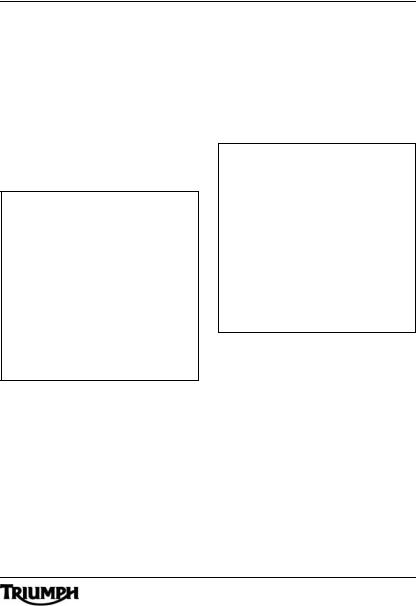
Serial Numbers
SERIAL NUMBERS
Vehicle Identification Number (V.I.N.)
The vehicle identification number is stamped into the steering head area of the frame. It is also displayed on a plate, riveted to the frame, beneath the rider’s seat.
Engine Serial Number
The engine serial number is stamped on the engine crankcase, towards the rear, on the right hand side.
17
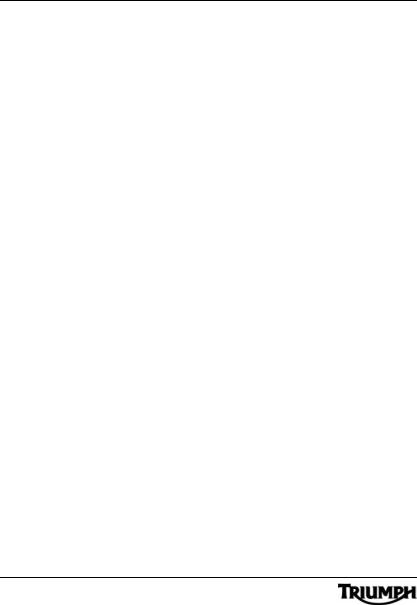
Serial Numbers
This page intentionally left blank
18
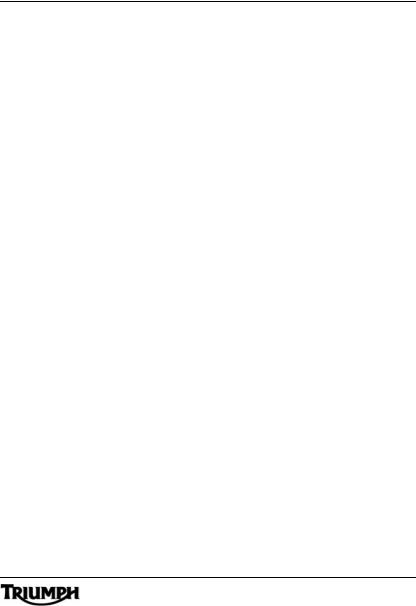
|
General Information |
GENERAL INFORMATION |
|
Table of Contents |
|
Instrument Panel Layout ........................................................................... |
20 |
Speedometer............................................................................................. |
21 |
Tachometer................................................................................................ |
21 |
Odometer/Trip Meter ................................................................................. |
21 |
Warning Lights........................................................................................... |
22 |
Low Oil Pressure Warning ................................................................... |
22 |
Coolant Temperature ........................................................................... |
22 |
Ignition Key................................................................................................ |
24 |
Ignition Switch/Steering Lock .................................................................... |
24 |
Ignition Switch Positions ...................................................................... |
24 |
Brake and Clutch Lever Adjuster............................................................... |
25 |
Right Handlebar Switches ......................................................................... |
26 |
Engine Stop Switch.............................................................................. |
26 |
Starter Button....................................................................................... |
27 |
Left Handlebar Switches............................................................................ |
27 |
Headlight Dip Switch............................................................................ |
27 |
Direction Indicator Switch .................................................................... |
27 |
Horn Button.......................................................................................... |
27 |
Fuel Requirement/Refuelling..................................................................... |
28 |
Fuel Grade........................................................................................... |
28 |
Fuel Tank Cap ........................................................................................... |
29 |
Filling the Fuel Tank .................................................................................. |
30 |
Stand ......................................................................................................... |
31 |
Side Stand ........................................................................................... |
31 |
Tool Kit and Handbook .............................................................................. |
31 |
Seat Lock .................................................................................................. |
32 |
Running-In................................................................................................. |
32 |
Safe Operation .......................................................................................... |
33 |
Daily Safety Checks............................................................................. |
33 |
|
19 |

General Information
Instrument Panel Layout
|
|
|
|
1 |
Speedometer |
9 |
High Beam Indicator Light |
2 |
Odometer/Trip Meter |
10 |
Neutral Indicator Light |
3 |
Trip reset knob |
11 |
Low Fuel Level Indicator Light |
4 |
Tachometer |
12 |
Alarm Status Indicator Light |
5 |
Tachometer ’red zone© |
|
(alarm is an accessory fit) |
|
|
6Engine Management Malfunction Indicator Light
7High Coolant Temperature/Low Oil Pressure Warning Light
8Turn Indicator light
20
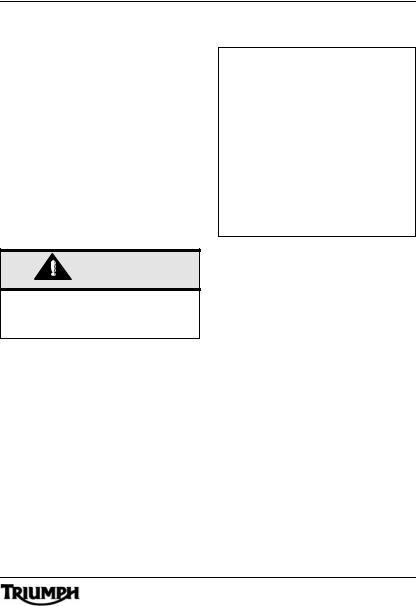
General Information
Speedometer
The speedometer indicates the road speed of the motorcycle.
Tachometer
The tachometer shows the engine speed in revolutions per minute - rpm (r/min). On the right side of the tachometer face is the ’red zone©. Engine rpm (r/min) in the red zone is above maximum recommended engine speed and is also above the range for best performance.
Caution
Never allow engine RPM to enter the ’red zone©as severe engine damage may result.
Odometer/Trip Meter
1Odometer/trip meter display
2Reset knob
The odometer shows the total distance that the motorcycle has travelled.
There are two trip meters. Either trip meter shows the distance that the motorcycle has travelled since the meter on display was last reset to zero.
To switch between the odometer and trip meter display modes, turn the reset knob anti-clockwise (as viewed from the left side of the motorcycle) and release when the desired display is visible. The display will scroll through in the order:
•Odometer
•Trip meter 1
•Trip meter 2
21
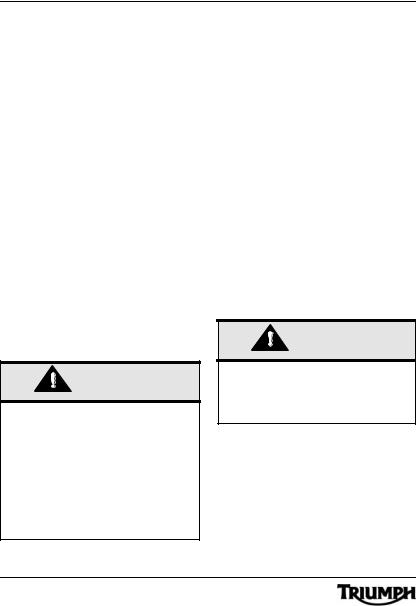
General Information
To reset either of the trip meters, select and display the trip meter to be zeroed then turn the reset knob anticlockwise (as viewed from the left side of the motorcycle) and hold it in the forward position for 2 seconds. After 2 seconds, the trip meter on display will reset to zero.
Warning Lights
Low Oil Pressure Warning
With the engine running, if the engine oil pressure becomes dangerously low, the high coolant temperature/low oil pressure warning light will illuminate and an arrow will appear on the digital display pointing to the low oil pressure warning symbol.
Caution
Stop the engine immediately if the low oil pressure warning light illuminates. Do not restart the engine until the fault has been rectified.
Severe engine damage will result from running the engine when the low oil pressure warning light is illuminated.
NOTE
•The high coolant temperature /low oil pressure warning light will illuminate and an arrow will appear on the digital display along side the low oil pressure warning symbol, if the ignition is switched on without running the engine.
Coolant Temperature
If the coolant temperature becomes too high, the high coolant temperature/low oil pressure
warning light will illuminate and an arrow will appear on the digital display pointing to the high coolant temperature symbol.
Caution
Do not continue to run the engine if the high coolant temperature warning is illuminated as severe engine damage may result.
Engine Management
System Malfunction Indicator Light
The malfunction indicator light for the engine management system illuminates when the ignition is switched on (to indicate that it is working) but should not become
22
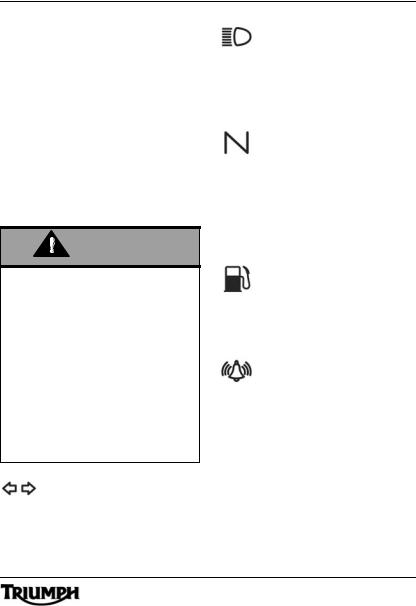
General Information
illuminated when the engine is running.
If the malfunction indicator light becomes illuminated when the engine is running, this indicates that a fault has occurred in one or more of the systems controlled by the engine management system. In such circumstances, the engine management system will switch to `limp-home©mode so that the journey may be completed, if the fault is not so severe that the engine will not run.
Warning
Reduce speed and do not continue to ride for longer than is necessary with the malfunction indicator light illuminated. The fault may adversely affect engine performance, exhaust emissions and fuel consumption. Reduced engine performance could cause a dangerous riding condition, leading to loss of control and an accident. Contact an authorised Triumph dealer as soon as possible to have the fault checked and rectified.
Turn Indicators
When the indicator switch is turned to left or right, the turn indicator light will flash on and off at the same speed as the turn
indicators.
High Beam
When the ignition is switched on and the headlight dip switch is set to ’high beam©, the high beam warning light
will illuminate.
Neutral
The neutral warning light indicates when the transmission is in neutral (no gear selected). The warning light will illuminate when the transmission is in neutral with the ignition switch in the
’ON©position.
Low Fuel
The low fuel indicator will illuminate when there are approximately 7.0 litres of fuel
remaining in the tank.
Alarm
The alarm light will illuminate when the conditions described in the accessory alarm
instructions are met.
23
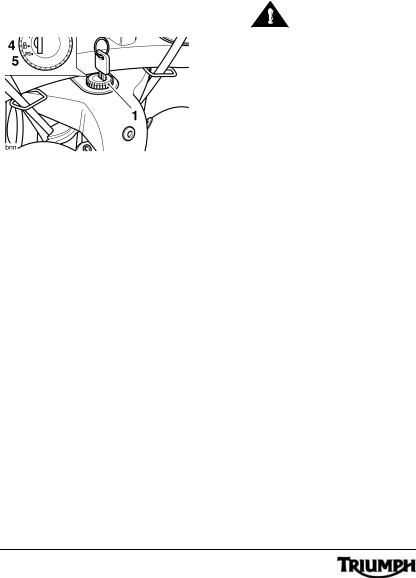
|
General Information |
|
|
|
|
|
|
|||
|
|
|
|
|
|
|
|
|
|
|
|
Ignition Key |
|
|
|
|
|
|
|
|
|
|
|
|
|
|
Caution |
|
|
|||
|
|
|
|
|
|
|
|
|
||
|
|
|
|
|
|
|
|
|
||
|
|
|
|
|
|
|
|
|
|
|
|
|
|
|
|
Do not store the spare key with the |
|
||||
|
|
|
|
|
motorcycle as this will reduce all |
|
||||
|
|
|
|
|
aspects of security. |
|
|
|
||
|
|
|
|
|
|
|
||||
|
|
|
|
|
Ignition Switch/Steering |
|||||
|
|
|
|
|
Lock |
|
|
|
|
|
|
|
|
|
|
Ignition Switch Positions |
|
|
|||
|
|
|
|
|
This is a four position, key operated |
|||||
|
|
|
|
|
switch. The key can be removed |
|||||
|
|
|
|
|
from the switch only when it is in the |
|||||
|
1 |
Steering lock |
|
|
||||||
2 |
Off position |
|
|
OFF, LOCK or P (PARK) position. |
||||||
3 |
On position |
|
|
TO LOCK: Turn the key to the ’OFF© |
||||||
4 |
Lock position |
|
|
position, push and fully release the |
||||||
5 |
Park position |
|
|
key, then rotate it to the ’LOCK© |
||||||
|
In addition to operating the steering |
position. |
|
|
|
|
||||
|
lock/ignition switch, the ignition key is |
’PARKING©: |
Turn the key from the |
|||||||
|
required to operate the seat lock and |
’LOCK©position to the `P©position. |
||||||||
|
fuel tank cap. |
|
|
The steering will remain locked. |
|
|
||||
|
When the motorcycle is |
delivered |
NOTE |
|
|
|
|
|||
|
from the factory, two keys are |
|
|
|
|
|||||
|
• Do not leave the steering lock |
|||||||||
|
supplied together with a small tag |
|||||||||
|
bearing the key number. |
Make a |
in the |
’P© position for |
long |
|||||
|
note of the key number and store the |
periods of time as this will |
||||||||
|
spare key and key number tag in a |
cause |
the |
battery |
to |
|||||
|
safe place away from the motorcycle. |
discharge. |
|
|
|
|||||
Your authorised Triumph dealer can supply a replacement key cut from details of the key number or can cut a new key using the original as a master.
24
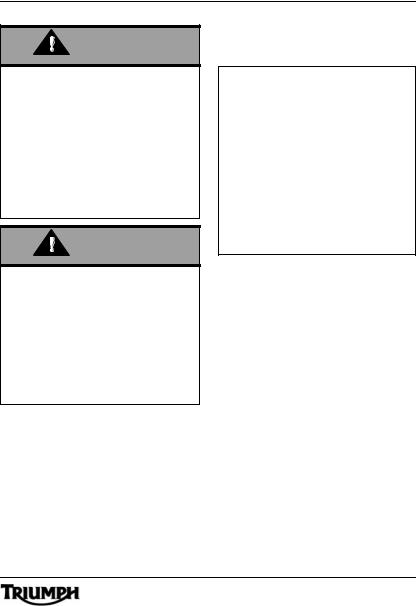
General Information
Warning
For reasons of security and safety, always move the ignition switch to the ’LOCK© or ’P’ position and remove the key, when leaving the motorcycle unattended.
Any unauthorised use of the motorcycle may cause injury to the rider, other road users and pedestrians and may also cause damage to the motorcycle.
Warning
With the key in the ’LOCK©or ’P© position the steering will become locked.
Never turn the key to the ’Lock©or ’P©positions while the motorcycle is moving as this will cause the steering to lock. Locked steering will cause loss of motorcycle control and an accident.
Brake and Clutch Lever
Adjuster
1Lever
2Adjuster wheel
3Triangular mark
An adjuster is fitted to the front brake and clutch levers. The adjusters allow the distance from the handlebar to the levers to be changed to one of four positions, to suit the span of the operator©s hands.
To adjust the levers, push each lever forward and turn the adjuster wheel to align one of the numbered positions with the triangular mark on the lever holder.
The distance from the handlebar grip to the released lever is shortest when set to number four and longest when set to number one.
25
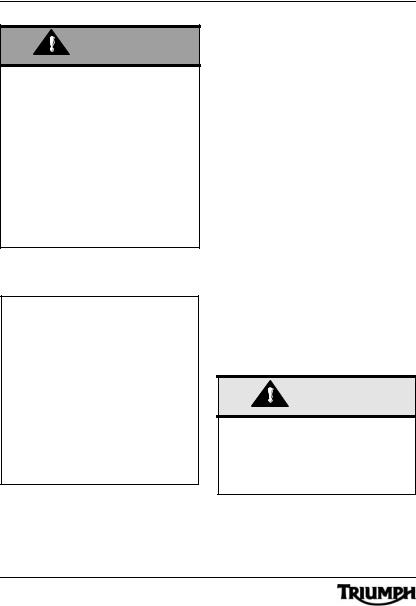
General Information
Warning
Do not attempt to adjust the levers with the motorcycle in motion as this may lead to loss of motorcycle control and an accident.
After adjusting the levers, operate the motorcycle in an area free from traffic to gain familiarity with the new lever setting. Do not loan your motorcycle to anyone as they may change the lever setting from the one you are familiar with causing loss of control or an accident.
Right Handlebar Switches
1Engine stop switch
2‘Run’ position
3‘Stop’ position
4Starter button
Engine Stop Switch
In addition to the ignition switch being turned to the ’ON© position, the engine stop switch must be in the ‘run’ position for the motorcycle to operate.
The engine stop switch is for emergency use. If an emergency arises which requires the engine to be stopped, move the engine stop switch to the stop position.
NOTE
•Although the engine stop switch stops the engine, it does not turn off all the electrical circuits and may cause difficulty in restarting the engine due to a discharged battery. Ordinarily, only the ignition switch should be used to stop the engine.
Caution
Do not leave the ignition switch in the ’ON©position unless the engine is running as this may cause damage to electrical components and will discharge the battery.
26
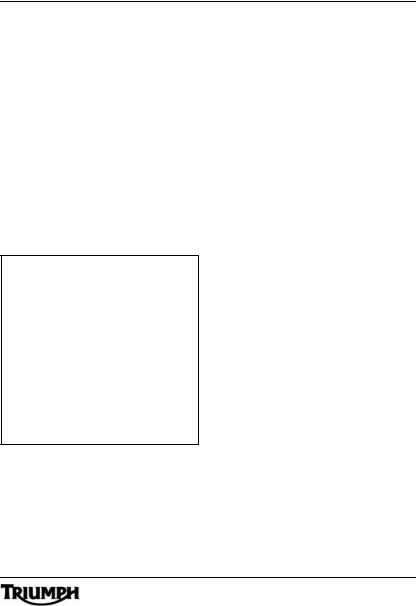
General Information
Starter Button
The starter button operates the electric starter. For the starter to operate, the clutch lever must be pulled to the handlebar.
NOTE
•Even if the clutch lever is pulled to the handlebar, the starter will not operate if the side stand is down and a gear is engaged.
Left Handlebar Switches
1Headlight dipswitch
2Direction indicator switch
3Horn button
forward. To select low beam, push the switch rearwards. When the high beam is turned on, the high beam indicator light will illuminate.
NOTE
•A lighting ON/OFF switch is not fitted to this model. The headlight, rear light and licence plate light all function automatically when the ignition is turned to the ON position.
Direction Indicator Switch
When the indicator switch is pushed to the left or right and released, the corresponding direction indicators will flash on and off. To turn off the indicators, push and release the switch.
Horn Button
When the horn button is pushed, with the ignition switch turned to the ’ON© position, the horn will sound.
Headlight Dip Switch
High or low beam can be selected with the headlight dip switch. To select high beam, push the switch
27
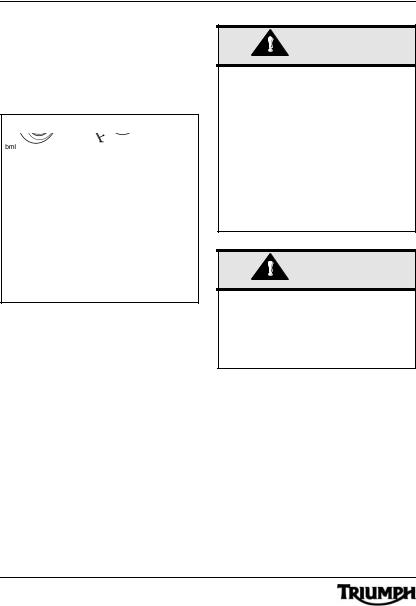
General Information
Fuel Requirement/
Refuelling
Fuel Grade
Your Triumph engine is designed to use unleaded fuel and will give optimum performance if the correct grade of fuel is used. Always use unleaded fuel with an octane rating of 95 RON.
Caution
In many countries, the exhaust system for this model is fitted with a catalytic converter to help reduce exhaust emission levels. The catalytic converter can be permanently damaged if the motorcycle is allowed to run out of fuel or if the fuel level is allowed to get very low. Always ensure you have adequate fuel for your journey.
Caution
The use of leaded fuel is illegal in some countries, states or territories. Use of leaded fuel will damage the catalytic converter (if fitted).
28

General Information
Warning
To help reduce hazards associated with refuelling, always observe the following fuel safety instructions:
Petrol (fuel) is highly flammable and can be explosive under certain conditions. When refuelling, turn the ignition switch to the `OFF© position.
Do not smoke.
Make sure the refuelling area is well ventilated and free from any source of flame or sparks. This includes any appliance with a pilot light.
Never fill the tank until the fuel level rises into the filler neck. Heat from sunlight or other sources may cause the fuel to expand and overflow creating a fire hazard.
After refuelling always check that the fuel filler cap is correctly closed and locked.
Because petrol (fuel) is highly flammable, any fuel leak or spillage, or any failure to observe the safety advice given above will lead to a fire hazard, which could cause damage to property, injury to persons or death.
Fuel Tank Cap
1Fuel tank cap
2Key
To open the fuel tank cap, lift up the flap covering the lock itself. Insert the key into the lock and turn the key clockwise.
To close and lock the cap, push the cap down into place with the key inserted, until the lock `clicks©into place. Withdraw the key and close the key cover.
Caution
Closing the cap without the key inserted will damage the cap, tank and lock mechanism.
29
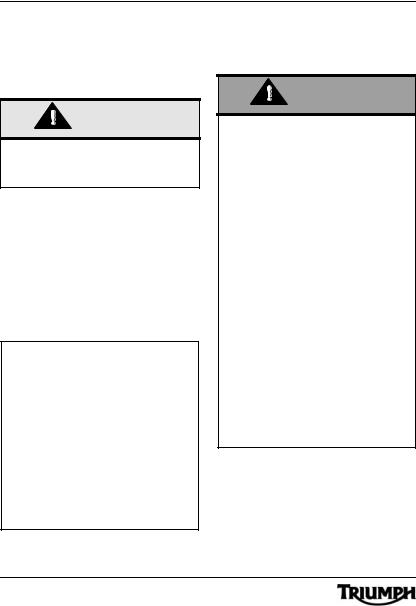
General Information
Filling the Fuel Tank
Avoid filling the tank in rainy or dusty conditions where airborne material can contaminate the fuel.
Caution
Contaminated fuel may cause damage to fuel system components.
Fill the fuel tank slowly to help prevent spillage. Do not fill the tank to a level above the bottom of the filler neck. This will ensure there is enough air space to allow for fuel expansion if the fuel inside the tank expands through absorption of heat from the engine or from direct sunlight.
After refuelling always check that the fuel filler cap is correctly closed and locked.
Warning
Overfilling the tank can lead to fuel spillage.
If fuel is spilled, thoroughly clean up the spillage immediately and dispose of the materials used safely.
Take care not to spill any fuel on the engine, exhaust pipes, tyres or any other part of the motorcycle.
Because fuel is highly flammable, any fuel leak or spillage, or any failure to observe the safety advice given above may lead to a fire hazard, which could cause damage to property and injury or death to persons.
Fuel spilled near to, or onto the tyres will reduce the tyre©s ability to grip the road. This will give rise to a dangerous riding condition potentially causing loss of motorcycle control and an accident.
1Fuel filler neck
2Maximum fuel level
30
